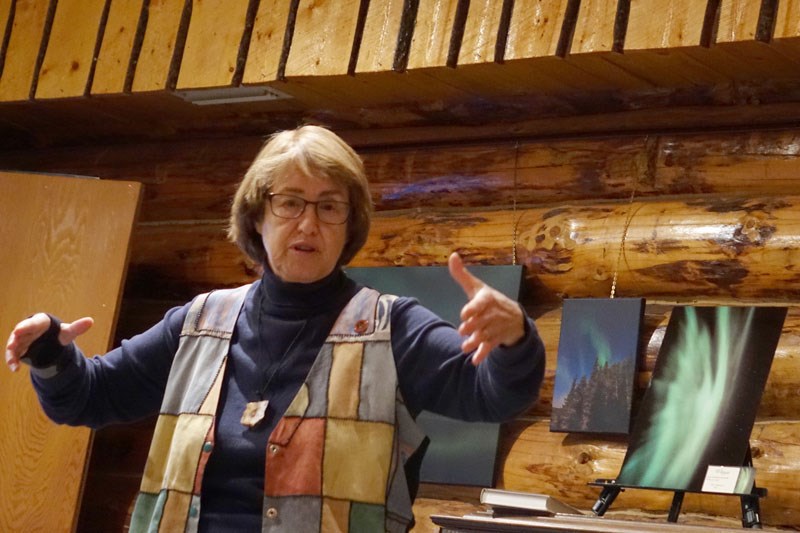Northern Ontario and Quebec wildlife tamer and trapper Joe LaFlamme was a tall man but the tales about him are even taller.
There's the one about the two moose he trained to eat at the kitchen table and walk up stairs, who also got airsick when he took them on a plane from Boston to New York. Still, that flight was calmer than the time he packed a plane full of his sled wolf team because he didn't want to take the train. And then there are the times he mushed with them in Toronto and down Broadway in New York.
Suzanne F. Charron, author of Wolf Man Joe LaFlamme: Tamer Untamed, regaled a small crowd in Thompson with anecdotes from her biographer of the larger than life character at the Heritage North Museum in October, while she was attending the second Wolf and Carnivore Conference, but it wasn't his outsized personality that first attracted her to LaFlamme's story: it was the wolves.
"I've always loved wolves and I though that was a fascinating story," said Charron, who first learned of LaFlamme when she was in her early 20s, decades before she published French and English biographies of the man in 2013.
But if you think this has the whiff of fiction, Charron says you couldn't be more wrong.
"I've had people tell me that this was an urban legend," said Charron. "He was a real legend. I don't think an urban legend would get two pages in Life magazine."
Born in 1889 in Quebec, the 6'2" LaFlamme moved to Montreal after his father died and then to Gogama, Ontario, two-and-a-half hours north of Sudbury with his much-shorter wife Lily, who was from Paris, in 1920. He worked for two lumber companies transporting provisions, by horse in the summer and dogsled in the winter. When many of the huskies who pulled his sled contracted distemper in 1923 and he subsequently found a wolf in a beaver trap, he decided to try something new.
"He hooked her onto his sleigh and said, 'Hmm, I'm going to try training wolves instead of my dogs for my mushing team.'"
Using wolves in place of dogs wasn't always easy, LaFlamme found, such as the time when he took them out to check his traps in very cold weather and then thought he wasn't going to be able to get them to pull him back to Gogama, until they found something to snack on - three beavers in LaFlamme's backpack.
"They ate the three beavers and they ate the backpack and after that, well, they were a little calmer," said Charron.
Another close call was when he decided to pack his wolves into a plane instead of taking them on a cold train trip to Sudbury.
"Imagine you're a timber wolf, you've never been anywhere but in the bush or in Joe's yard and then you're going in a plane which makes a lot of noise to start off with and you're going on a slant," said Charron. "Imagine the reaction of the wolves. They started fighting and everything and he got out of there. The canvas walls were all torn or shredded and so were his mukluks so he was lucky to get out alive."
Around 1940, LaFlamme decided to give up training wolves and keep moose instead.
"He trained them to be house trained and once that was done they could go have breakfast at their family table so they had their bowl of porridge," said Charron.
The moose were also taught to walk up stairs, a trick they used at the local pub as well as their home.
"The local pub had a few stairs, too, so when they walked those stairs they had a cold beer and several people have told me that," said Charron.
Starting out with a handful of newspaper articles to work from, Charron said it took her four years to research and write both the French and English versions.
"I used archives, I used museums, I used a lot of newspaper articles from Northern Ontario to Louisiana," said Charron, as well as personal interviews, which enabled her to gather information that would otherwise have been lost.
"From the time I started interviewing people who knew Joe Flamme, eight people I interviewed have died."
She also accomplished the task without any outside assistance.
"I refused to get a grant to write that book because that was my first project," Charron said. "I didn't want to have the pressure of that because when you go and get a grant you've got a time limit. I didn't want that because I didn't know where it would take me."
In the process, the author indulged her true passion.
"I majored in the science of languages or linguistics with a minor in history," she said. "I should have done it the other way round. I always loved history, local history like that. It's important. If I hadn't written the book his memory would have been lost, his story would have been lost and it's a great story."
The second English edition of Wolf Man Joe LaFlamme: Tamer Untamed is published by Latitude 46 publishing.




